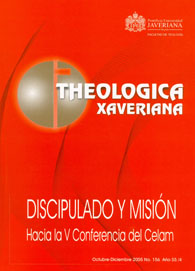Abstract
La educación de la juventud, según el Concilio Vaticano II, identifica una de las tareas fundamentales del mundo actual. De ello depende su presente y su futuro. En este escenario la universidad juega un rol insustituible y cuando el reto se asume con criterios cristianos, la universidad propone a sus destinatarios el más alto paradigma humano: la opción por Jesús de Nazaret. En este orden de ideas el discipulado de Jesús no constituye una propuesta más sino la oportunidad
efectiva para ser constructores de una nueva sociedad, a partir del servicio y la entrega desinteresada por el bien de los semejantes.
AEBLI, HANS, 12 formas básicas de enseñar, Narcea, Madrid, 1998.
Biblia Latinoamericana, San Pablo, Madrid, 1996.
BRANDT, PIERRE-YVES, L’identité de Jésus et l’identité de son disciple: Le récit de la transfiguration comme clef de lecture de l’Évangile de Marc, Novum Testamentum et Orbis Antiquus, 050, Vandenhoeck & Ruprecht,
Göttingen, 2002.
BROWN, RAYMOND, Las Iglesias que los apóstoles nos dejaron, Desclée de Brouwer, Bilbao, 1986. La comunidad del discípulo amado, Sígueme, Salamanca, 1991.
CLAUDEL, GÉRARD, “À la recherche du disciple modèle de Matthieu”, en Revue des sciences religieuses 79, 2005.
COPLIN, HILL, 10 factores claves de éxito en la empresa (universidad), Deusto, Barcelona, 2005.
CURKPATRICK, STEPHEN, “A Disciple for our Time. A Conversation”, en Interpretation 55/3, 2001, pp. 285-291.
DUNCAN, GREY, “100 Esential Lists for Teachers”, en Continuum Education,
Madrid, 2005.
EASLEY, KENDELL H., “Religion, Duty, and the Disciple”, en Southwestern Journal of theology 46/3, 2004.
FRIEDRICHSEN, TIMOTHY A., “Disciple(s) in the New Testament. Background, Usage, Characteristics and Historicity”, en Salesianum 65/4, 2003, pp. 717-739.
HATTON, STEPHEN B., “Mark’s Naked Disciple: The Semiotics and Comedy of Following”, en Neotestamentica 35, 2001, pp. 35-48.
KLAUSNER, JOSEPH, Jesús de Nazaret: su vida, su época, sus enseñanzas, Ediciones Paidós Ibérica, Barcelona, 2006.
LAMIRANDE, ÉMILIEN, “Marie-Madeleine disciple, temoin et apôtre, d’après
l’ancienne littérature chrétienne. I. Données évangéliques et littérature
apocryphe ou gnostique”, en Science et esprit 56, 2004, pp. 153-170.
LOHFINK, GERHARD, El sermón de la montaña ¿para quién? Herder, Barcelona, 1989.
PAFFENROTH, KIM, Judas: Images of the Lost Disciple, John Knox, Louisville, KY, Westminster, 2001.
REINHARTZ, ADELE, Befriending the Beloved Disciple: A Jewish reading of the Gospel of John, Continuum, New York, 2001.
RESTREPO, CARLOS, La universidad ayer, la universidad hoy, IEC, Bogotá, 1989.
RIERA, FRANCESC, Jesús de Nazaret: el Evangelio de Lucas, escuela de justicia y misericordia, Bilbao, 2002.
SALESIANOS DE DON BOSCO, Constituciones y Reglamentos, SCCS, Madrid, 1985.
SILVA RETAMALES, SANTIAGO, Discípulo y discipulado en San Lucas, Celam, Bogotá, 2005.
SKA, JEAN-LOUIS, Abrahán y sus huéspedes, Verbo Divino, Estella, 2004.
UNIVERSIDAD DE ANTIOQUIA, Alma Mater, periódico de la Universidad de Antioquia. No 536, Medellín, septiembre de 2005.
VANIER, JEAN, Acceder al misterio de Jesús a través del Evangelio de Juan,
Editorial Sal Terrae, Santander, 2005.
VARIOS, Educación superior, sociedad e investigación, Colciencias-Ascún,
Bogotá, 2002.
This journal is registered under a Creative Commons Attribution 4.0 International Public License. Thus, this work may be reproduced, distributed, and publicly shared in digital format, as long as the names of the authors and Pontificia Universidad Javeriana are acknowledged. Others are allowed to quote, adapt, transform, auto-archive, republish, and create based on this material, for any purpose (even commercial ones), provided the authorship is duly acknowledged, a link to the original work is provided, and it is specified if changes have been made. Pontificia Universidad Javeriana does not hold the rights of published works and the authors are solely responsible for the contents of their works; they keep the moral, intellectual, privacy, and publicity rights.
Approving the intervention of the work (review, copy-editing, translation, layout) and the following outreach, are granted through an use license and not through an assignment of rights. This means the journal and Pontificia Universidad Javeriana cannot be held responsible for any ethical malpractice by the authors. As a consequence of the protection granted by the use license, the journal is not required to publish recantations or modify information already published, unless the errata stems from the editorial management process. Publishing contents in this journal does not generate royalties for contributors.


